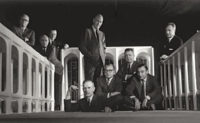Palladio Still Relevant 500 Years After His Birth

Palladio Still Relevant 500 Years After His Birth
Villa Almerico Capra (La Rotonda) near Vicenza.
Photo courtesy Institute for Classical Architecture & Classical America

Palladio Still Relevant 500 Years After His Birth
Tempietto Barbaro, a chapel at the Villa Barbaro in Maser.
Photo courtesy Institute for Classical Architecture & Classical America

Palladio Still Relevant 500 Years After His Birth
Loggia del Capitanio in Vicenza.
Photo courtesy Institute for Classical Architecture & Classical America

Palladio Still Relevant 500 Years After His Birth
Villa Cornaro in Piombino Dese.
Photo courtesy Institute for Classical Architecture & Classical America

Palladio Still Relevant 500 Years After His Birth
Villa Cornaro in Piombino Dese.
Photo courtesy Institute for Classical Architecture & Classical America




Post a comment to this article
Report Abusive Comment